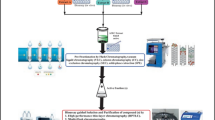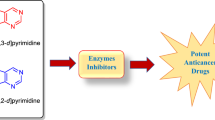Abstract
Lapachol (1) is a well-studied natural product isolated from plants of the Bignoniaceae family and demonstrates diverse biological effects. Historically, chemical transformation of the lapachol scaffold has yielded new derivatives with impressive biological activity and rich chemical diversity. β-lapachone (2), α-lapachone (3), and 2-acetylfuronaphthoquinone (4) are examples of analogs derived from lapachol that show superior antitumor activity compared with the natural product. In the present study, novel indane carboxylic acid: 2,2-dimethyl-2,3-dihydroindeno[1,2-b]pyran-4,5-dione (9) and methyl 5-hydroxy-2,2-dimethyl-2,3,4,5-tetrahydroindeno[1,2-b]pyran-5-carboxylate (10) and naphthoquinone derivatives were synthesized from lapachol with structural similarities to the antitumor lapachol derivatives. The synthesized compounds were evaluated for antiproliferative activities against a panel of human cancer cell lines including in vitro models for neuroblastoma, melanoma, glioblastoma, and non-small cell lung cancer. As expected, the most potent derivatives were those incorporating β-naphthoquinone and α-naphthoquinono[2,3-b]furan skeletons. Many of these compounds possessed nanomolar to single digit micromolar antiproliferative potency. However, the most interesting analog evaluated was the dione 9 with an indeno[1,2-b]pyran skeleton, which demonstrated potent cytotoxic activity. The current investigation identified several new lead compounds that could be used as starting points for anticancer drug discovery.



Similar content being viewed by others
References
Aksenov AV, Smirnov AN, Magedov IV, Reisenauer MR, Aksenov NA, Aksenova IV, Pendleton AL, Nguyen G, Johnston RK, Rubin M, De Carvalho A, Kiss R, Mathieu V, Lefranc F, Correa J, Cavazos DA, Brenner AJ, Bryan BA, Rogelj S, Kornienko A, Frolova LV (2015) Activity of 2-Aryl-2-(3-indolyl)acetohydroxamates against drug-resistant cancer cells. J Med Chem 58(5):2206–2220
Amann VC, Ramelyte E, Thurneysen S, Pitocco R, Bentele-Jaberg N, Goldinger SM, Dummer R, Mangana J (2017) Developments in targeted therapy in melanoma. Eur J Surg Oncol 43(3):581–593
Bolton JL, Trush MA, Penning TM, Dryhurst G, Monks TJ (2000) Role of quinones in toxicology. Chem Res Toxicol 13(3):135–160
Castellanos JRG, Prieto JM, Heinrich M (2009) Red Lapacho (Tabebuia impetiginosa)—a global ethnopharmacological comomodity? J Ethnopharmacol 121:1–13
Dahlin JL, Nissink JWM, Strasser JM, Francis S, Higgins LA, Zhou H, Zhang Z, Walters MA (2015) PAINS in the assay: chemical mechanisms of assay interference and promiscuous enzymatic inhibition observed during a sulfhydryl-scavenging HTS. J Med Chem 58(5):2091–2113
Dasari R, De Carvalho A, Medellin DC, Middleton KN, Hague F, Volmar MNM, Frolova LV, Rossato MF, De La Chapa JJ, Dybdal-Hargreaves NF, Pillai A, Kälin RE, Mathieu V, Rogelj S, Gonzales CB, Calixto JB, Evidente A, Gautier M, Munirathinam G, Glass R, Burth P, Pelly SC, Van Otterlo WA, Kiss R, Kornienko A (2015) Wittig derivatization of sesquiterpenoid polygodial leads to cytostatic agents with activity against drug resistant cancer cells and capable of pyrrolylation of primary amines. Eur J Med Chem 103:226–237
da Silva Jr EN, de Souza MCBV, Pinto AV, Pinto MCFR, Goulart MOF, Barros FWA, Pessoa C, Costa-Lotufo LV, Montenegro RC, de Moraes MO, Ferreira VF (2007) Synthesis and potent antitumor activity of new arylamino derivatives of nor-beta-lapachone and nor-alpha-lapachone. Bioorg Med Chem 15:7035–7041
Esposito MR, Aveic S, Seydel A, Tonini GP (2017) Neuroblastoma treatment in the post-genomic era. J Biomed Sci 24(1):14
Eyong KO, Krohn K, Hussain H, Folefoc GN, Nkengfack AE, Schulz B, Hu Q (2005) Newbouldiaquinone and newbouldiamide: a new naphthoquinone– anthraquinone coupled pigment and a new ceramide from Newbouldia laevis. Chem Pharm Bull 53(6):616–619
Eyong KO, Folefoc GN, Kuete V, Beng VP, Hussain H, Krohn K, Nkengfack AE, Saeftel M, Sarite SR, Achim H (2006) Newbouldiaquinone A: a naphthoquinone-anthraquinone ether coupled pigment, as a potential antimicrobial and antimalarial agent from Newbouldia laevis. Phytochemistry 67:605–609
Eyong KO, Kumar SM, Folefoc GN, Nkengfack AE, Baskaran S (2008) Semisynthesis and antitumoral activity of 2-acetylfuranonaphthoquinone and other naphthoquinone derivatives from lapachol. Bioorg Med Chem Lett 18:5387–5390
Eyong KO, Puppala M, Kumar PM, Lamshöft M, Folefoc GN, Spiteller M, Baskaran S (2013) A mechanistic study on the Hooker oxidation: synthesis of novel indane carboxylic acid derivatives from lapachol. Org Biomol Chem 11:459–468
Eyong KO, Chinthapally K, SenthilKumar S, Lamshöft M, Folefoc GN, Baskaran S (2015a) Conversion of lapachol to lomatiol: synthesis of novel naphthoquinone derivatives. New J Chem 39:9611–9616
Eyong KO, Ketsemen LH, Ghansenyuy YS, Folefoc NG (2015b) Chemical constituents, the stereochemistry of 3-hydroxy furonaphthoquinones from the root bark of Newbouldia laevis Seem (Bignoniaceae), and screening against Onchocerca ochengi parasites. Med Chem Res 24:965–969
Fiorito S, Epifano F, Bruyère C, Mathieu V, Kiss R, Genovese S (2014) Growth inhibitory activity for cancer cell lines of lapachol and its natural and semi-synthetic derivatives. Bioorg Med Chem Lett 24:454–457
Habtemariam S (2010) Knipholone anthrone from Kniphofia foliosa induces a rapid onset of necrotic cell death in cancer cells. Fitoterapia 81(8):1013–1019
Hussain H, Krohn K, Ahmad VU, Miana GA, Green IR (2007) Lapachol: an overview. Arkivoc 2:145–171
Induli M, Gebru M, Abdissa N, Akala H, Wekesa I, Byamukama R, Heydenreic M, Murunga S, Dagne E, Yenesew A (2013) Antiplasmodial quinones from the rhizomes of Kniphofia foliosa. Nat Prod Commun 8(9):1261–1264
Kuete V, Eyong KO, Folefoc NG, Beng VP, Hussain H, Krohn K, Nkengfack AE (2007) Antimicrobial activity of the methanolic extract and of the chemical constituents isolated from Newbouldia laevis. Pharmazie 62:552–556
Kornienko A, Mathieu V, Rastogi SK, Lefranc F, Kiss R (2013) Therapeutic agents triggering nonapoptotic cancer cell death. J Med Chem 56(12):4823–4839
Li Y, Li CJ, Yu D, Pardee AB (2000) Potent induction of apoptosis by beta-lapachone in human multiple myeloma cell lines and patient cells. Mol Med 6(12):1008–1015
Lim SM, Jeong Y, Lee S, Im H, Tae HS, Kim BG, Park HD, Park J, Hong S (2015) Identification of β-Lapachone analogs as Novel MALT1 inhibitors to treat an aggressive subtype of diffuse large B-cell lymphoma. J Med Chem 58:8491–8502
Monks TJ, Hanzlik RP, Cohen GM, Ross D, Graham DG (1992) Quinone chemistry and toxicity. Toxicol Appl Pharmacol 112(1):2–16
Nepomuceno JC (2011) Lapachol and its derivatives as potential drugs for cancer treatment. iConcept Press, Brazil
Oliveira MF, Lemos TLG, Mattos MCD, Segundo TA, Santiago GMP, Braz-Filho R (2002) New enamine derivatives of lapachol and biological activity. An da Academia Brasileira de Ciências 74:211–221
Osuka S, Van Meir EG (2017) Overcoming therapeutic resistance in glioblastoma: the way forward. J Clin Invest 127(2):415–426
Perez-Sacau E, Dıaz-Penate RG, Estevez-Braun A, Ravelo AG, Garcıa-Castellano JM, Pardo L, Campillo M (2007) Synthesis and pharmacophore modeling of naphthoquinone derivatives with cytotoxic activity in human promyelocytic leukemia HL-60 cell line. J Med Chem 50:696–706
Queiroz MLS, Valadares MC, Torello CO, Ramos AL, Oliveira AB, Rocha FD, Arruda VA, Accorei WR (2008) Comparative studies of the effects of Tabebuia avellanedae bark extract and beta-lapachone on the hematopoietic response of tumour-bearing mice. J Ethnopharmacol 117:228–235
Ramos-Perez C, Lorenzo-Castrillejo I, Quevedo O, Garcia-Luis J, Matos-Perdomo E, Medina-Coello C, Estevez-Braun A, Machin F (2014) Yeast cytotoxic sensitivity to the antitumour agent β-lapachone depends mainly on oxidative stress and is largely independent of microtubule- or topoisomerase- mediated DNA damage. Biochemical Pharmacol 92:206–219
Rios-Luci C, Bonifazi EL, Leon LG, Montero JC, Burton G, Pandiella A, Misico RI, Padron JM (2012) β-Lapachone analogs with enhanced antiproliferative activity. Eur J Medicinal Chem 53:264–274
Rossi A, Sacco PC, Santabarbara G, Sgambato A, Casaluce F, Palazzolo G, Maione P, Gridelli C (2017) Developments in pharmacotherapy for treating metastatic non-small cell lung cancer. Expert Opin Pharmacother 18(2):151–163
Souza-Silva F, Nascimento SB, Bourguignon SC, Pereira BA, Carneiro PF, Da Silva WS, Alves CR, De Pinho RT (2014) Evidences for leishmanicidal activity of the naphthoquinone derivative epoxy-α-lapachone. Exp Parasitol 147:81–84
Sunassee SN, Veale CGL, Shunmoogam-Gounden N, Osoniyi O, Hendricks DT, Caira MR, de la Mare J-A, Edkins AL, Pinto AV, da Silva Jr EN, Davies-Coleman MT (2013) Cytotoxicity of lapachol, β-lapachone and related synthetic 1,4-napthoquinones against oesophageal cancer cells. Eur J Med Chem 62:98–110
Tanis SP, Chuang YH, Head DB (1988) Furans in synthesis. 8. Formal total syntheses of (.+-.)- and (+)-aphidicolin. J Org Chem 53:4929–4938
Ueda S (2005) The present invention relates to a novel compound possessing antitumor activity, and an antitumor agent comprising said compounds. US Patent 5663197
Yamashita M, Kaneko M, Iida A, Tokuda H, Nishimura K (2007) Stereoselective synthesis and cytotoxicity of a cancer chemopreventive naphthoquinone from Tabebuia avellanedae. Bioorg Med Chem Lett 17(23):6417–6420
Zhao Z, Ma X, Sung D, Li M, Kosti A, Lin G, Chen Y, Pertsemlidis A, Th H, Du L (2015) microRNA-449a functions as a tumor suppressor in neuroblastoma through inducing cell differentiation and cell cycle arrest. RNA Biol 12(5):538–554
Zhao Z, Ma X, Shelton SD, Sung DC, Li M, Hernandez D, Zhang M, Losiewicz MD, Chen Y, Pertsemlidis A, Yu X, Liu Y, Du L (2016) A combined gene expression and functional study reveals the crosstalk between N-Myc and differentiation-inducing microRNAs in neuroblastoma cells. Oncotarget 7:79372–79387
Acknowledgements
The authors would like to acknowledge the council for International Exchange of Scholars (CIES) for the J. William Fulbright Visiting Scholar program to Pr Kenneth Eyong. The Molecular Bioscience Center, the CPRIT Synthesis and Drug-Lead Discovery Laboratory and the Departments of Chemistry/Biochemistry and Biology at Baylor University, and Baylor University and Texas State University, San Marcos for infrastructure and financial support. The University of Yaounde I and the Government of Cameroon for financial support through the Fonds d’Appuis a la Recherche.
Author information
Authors and Affiliations
Corresponding author
Ethics declarations
Conflict of interest
The authors declare no conflict of interest.
Additional information
Publisher’s note Springer Nature remains neutral with regard to jurisdictional claims in published maps and institutional affiliations.
Supplementary information
Rights and permissions
About this article
Cite this article
Eyong, K.O., Ketsemen, H.L., Zhao, Z. et al. Antiproliferative activity of naphthoquinones and indane carboxylic acids from lapachol against a panel of human cancer cell lines. Med Chem Res 29, 1058–1066 (2020). https://doi.org/10.1007/s00044-020-02545-0
Received:
Accepted:
Published:
Issue Date:
DOI: https://doi.org/10.1007/s00044-020-02545-0




